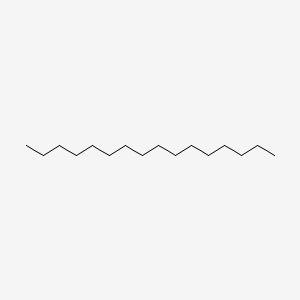| MeSH term | MeSH ID | Detail |
|---|---|---|
| Lupus Erythematosus, Systemic | D008180 | 43 associated lipids |
| Body Weight | D001835 | 333 associated lipids |
| Coronary Disease | D003327 | 70 associated lipids |
| Peritonitis | D010538 | 38 associated lipids |
| Hyperplasia | D006965 | 34 associated lipids |
| Glomerulonephritis | D005921 | 35 associated lipids |
| Encephalomyelitis, Autoimmune, Experimental | D004681 | 26 associated lipids |
| Keratosis | D007642 | 9 associated lipids |
| Serratia Infections | D016868 | 2 associated lipids |
Hexadecane
Hexadecane is a lipid of Fatty Acyls (FA) class. The involved functions are known as Analyte. The related lipids are Fatty Acids and palmitoleic acid.
Cross Reference
Introduction
To understand associated biological information of Hexadecane, we collected biological information of abnormalities, associated pathways, cellular/molecular locations, biological functions, related genes/proteins, lipids and common seen animal/experimental models with organized paragraphs from literatures.
What diseases are associated with Hexadecane?
There are no associated biomedical information in the current reference collection.
Possible diseases from mapped MeSH terms on references
We collected disease MeSH terms mapped to the references associated with Hexadecane
PubChem Associated disorders and diseases
What pathways are associated with Hexadecane
There are no associated biomedical information in the current reference collection.
PubChem Biomolecular Interactions and Pathways
Link to PubChem Biomolecular Interactions and PathwaysWhat cellular locations are associated with Hexadecane?
There are no associated biomedical information in the current reference collection.
What functions are associated with Hexadecane?
Related references are published most in these journals:
| Function | Cross reference | Weighted score | Related literatures |
|---|
What lipids are associated with Hexadecane?
Related references are published most in these journals:
| Lipid concept | Cross reference | Weighted score | Related literatures |
|---|
What genes are associated with Hexadecane?
There are no associated biomedical information in the current reference collection.
What common seen animal models are associated with Hexadecane?
There are no associated biomedical information in the current reference collection.
NCBI Entrez Crosslinks
All references with Hexadecane
Download all related citations| Authors | Title | Published | Journal | PubMed Link |
|---|---|---|---|---|
| Middelhoven WJ et al. | Phylogenetic position and physiology of Cerinosterus cyanescens. | 2000 | Antonie Van Leeuwenhoek | pmid:10959560 |
| Vomberg A and Klinner U | Distribution of alkB genes within n-alkane-degrading bacteria. | 2000 | J. Appl. Microbiol. | pmid:10971768 |
| Kito M et al. | Metabolism of the phosphatidylglycerol molecular species in Escherichia coli. | 1975 | Eur. J. Biochem. | pmid:1097251 |
| Lueking DR and Goldfine H | The involvement of guanosine 5-diphosphate-3-diphosphate in the regulation of phospholipid biosynthesis in Escherichia coli. Lack of ppGpp inhibition of acyltransfer from acyl-ACP to sn-glycerol 3-phosphate. | 1975 | J. Biol. Chem. | pmid:1097434 |
| Rodgers RP et al. | Stable isotope incorporation triples the upper mass limit for determination of elemental composition by accurate mass measurement. | 2000 | J. Am. Soc. Mass Spectrom. | pmid:11014445 |
| Vogel S et al. | Characterization of a new member of the fatty acid-binding protein family that binds all-trans-retinol. | 2001 | J. Biol. Chem. | pmid:11022035 |
| Iwabuchi N et al. | Relationships between colony morphotypes and oil tolerance in Rhodococcus rhodochrous. | 2000 | Appl. Environ. Microbiol. | pmid:11055965 |
| Nikitenko SI et al. | Volatile metal beta-diketonates--new precursors for the sonochemical synthesis of nanosized materials--sonolysis of thorium(IV) beta-diketonates. | 2000 | Ultrason Sonochem | pmid:11062872 |
| Haderlein A et al. | The design and use of aerated microcosms in mineralization studies. | 1999 | Biodegradation | pmid:11068830 |
| Brigger I et al. | Near infrared with principal component analysis as a novel analytical approach for nanoparticle technology. | 2000 | Pharm. Res. | pmid:11087046 |
